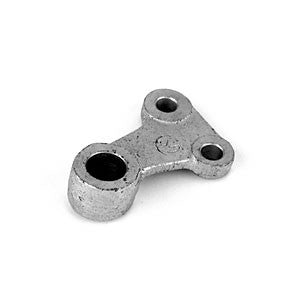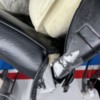I decided to try out a long throw slave on the clutch and yes it works just fine. I had my daughter help with the bleeding and saw that each time she pushed the pedal, the seat back was ready to snap off from so much bending. I drive with the seat up against the "firewall" so it's locked solid in place but the pedal takes one hell of a push. I am pretty sure that I can go back to the original (new too) slave and make it work correctly with less effort. Everything is new, clips, pins, etc. except the plastic line which I am replacing but I doubt if the new braided line will give me any more tiny millimetres of extra "throw". Just for "fun" I measured the throw with the plastic line and will measure again with the braided line to see if any difference which I doubt. Looks like every damn mm counts which is kind of silly on such a car.
Replies sorted oldest to newest
The size of the line will not make any difference as long as there is no air. The amount of fluid leaving the master will be the same amount entering the slave.
@forestg posted:The size of the line will not make any difference as long as there is no air. The amount of fluid leaving the master will be the same amount entering the slave.
Unless we imagine that the plastic line is expanding, in which case the volume used to expand the plastic line does not enter in the slave. There could therefore be a VERY slight increase in slave travel with a breaded steel line.
Does your pedal box have the clutch effort reduction installed? If it does there is a new part available with roller bearings. If it does not have the effort reduction then adding it could help. The image below is the primary component in the kit but this image does not have the roller bearings.

Thanks, no, it does not have the reduction mechs. I have only looked under there to check that out. For the plastic line, I was just wondering if it expands when pressed but if so, not much I believe. Anyway, I was going to check. Thanks for help. At first I was just worried about breaking the seat back, now its just my leg.
That red plastic line seems indestructible. But logically it should become less susceptible to ballooning as it ages because plastic usually gets harder as it ages.
Larry
In one Pantera I have a Centerforce diaphragm clutch and ended up taking out the clutch effort reduction kit because the clutch pedal tended to be very on/off. The clutch now works well and does not take much leg strength.
In another Pantera I have a McCleod long finger clutch and it was very difficult to press the clutch pedal. It took a lot of effort and did not seem correct. I added the effort reduction kit and clutch was immediately friendly. It would be difficult to drive this car without the effort reduction kit.
Steve ,
Thanks, interesting observations.
I have driven 2511 a little over 50,000 miles during my ownership using a three finger long-style pressure plate. My car does not have the clutch effort reduction kit, but I have never thought the clutch effort was difficult or excessive
It does, however, have an internal McLoud hydraulic throwout bearing. Whether that is the crucial piece or not, I can’t be sure, because I don’t have any other personal points of reference.
between Long style and diaphragm pressure plates, effort reduction kits, OEM system or long-throw slave upgrade, or internal hydraulic throwout bearing there are a lot of possible operational variations.
I do think it’s safe to say, that no matter what combination is being used in a Pantera, it requires notably more effort than that of a modern manual transmission vehicle
My 2¢
Larry
Thanks all for info. I'll just use it and play around a bit with getting the slack out of system. I have had other cars with the plastic lines and they do last forever and very hard. Last question, do the effort reduction kits still exist?
Dan
Yes, the reduction kits still exist and are available from most of our vendors. It is probably best to look for the one with roller bearings.
Dan, on your seat bending observation, '73-74 seats have the back frame welded to the seat base frame. These welds are often cracked on one side or the other. The '71-'72 seats are made in 2 separate parts using four large allen bolts to hold the backs to the bases. You should check which seats you have and if they're cracked (unsafe). The early seat construction not only eliminates seat-frame cracking, it allow one to change the recline angle of the backs a little by loosening the bolts behind a seat, adjusting the angle and re-snugging the knobs.
Since I added 2" OD knobs to the seat-back bolts in 1988, I can adjust our '72 for seat-rake in seconds while driving (on straight roads). Makes long road trips a bit more comfortable in 99%-stock seats, with no travel delay or cost.. Further, by cutting the bottom of the slots off early seat back straps, the backs can be easily folded onto their bases for working around the rear firewall, without removing bolts, only loosening them.
I had to weld and reinforce the seat back pan where it attaches to the base on both sides, as the seat flexed quite a bit. When I pulled the upholstery back it looked like someone had welded the crack before. I guess it’s common.
Not he best pic but it’s all that I had.
Attachments
Hi, thanks for the information. I'll check the seats for cracks! Didn't think about that one. Dan


